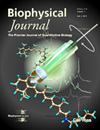许多动力蛋白团队在大型细胞器的运输过程中共同产生高的力。
IF 3.1
3区 生物学
Q2 BIOPHYSICS
引用次数: 0
摘要
细胞器的运输对维持细胞的组织和功能至关重要。几微米大小的大型细胞器的有效逆行运输需要来自多个动力马达的高集体力。然而,对于大型细胞器,确切的运输力及其对货物大小的依赖是未知的。此外,尚不清楚在这种运输过程中有多少动力蛋白马达是活跃的,以及它们如何产生足以克服细胞质阻力的高集体力。我们测量了直径在1到5 μm之间的吞噬体在逆行运输过程中产生的力。作用力随吞噬体体积的增加而增加,最小的吞噬体小于10 pN,最大的吞噬体为160 pN。这些力与细胞质阻力相匹配,以实现所有大小的吞噬体以25±4 nm s-1的速度同样快速的运输。为了确认需要许多动力蛋白马达来产生如此高的力,我们在分离的吞噬体上标记和量化了动力蛋白。我们在最大的吞噬体上发现了多达250个动力蛋白,并且动力蛋白的表面密度与吞噬体的大小无关。我们将动力蛋白数和输运力与细胞器周围微管分布的理论模型联系起来。该模型表明,由于较大的细胞器位移和弯曲微管,不成比例的大量动力蛋白可以活跃,并有助于大型吞噬体的高运输力。我们的研究结果表明,在大型细胞器的运输过程中,许多动力蛋白与多个微管以货物尺寸依赖的方式相互作用,以获得足够大的运输力。本文章由计算机程序翻译,如有差异,请以英文原文为准。
Main Manuscript for Many dynein teams collectively generate high forces during the transport of large organelles.
The transport of organelles is important to maintain cellular organization and function. Efficient retrograde transport of large organelles with a size of several micrometers requires high collective forces from multiple dynein motors. However, the exact transport forces and their dependence on the cargo size are unknown for large organelles. Furthermore, it is not known how many dynein motors are active during this transport and how they to generate high collective forces sufficient to overcome the cytoplasmic drag. We measured forces generated during retrograde transport of phagosomes with diameters between 1 and 5 μm. Forces increased with phagosome volume and ranged from under 10 pN for the smallest up to 160 pN for the largest phagosomes. These forces matched the cytoplasmic drag to achieve equally fast transport with a velocity of 25 ± 4 nm s-1 for phagosomes of all sizes. To confirm the need for many dynein motors to generate such high forces, we labeled and quantified dynein on isolated phagosomes. We found up to 250 dyneins on the largest phagosomes and a dynein surface density which was independent of the phagosome size. We connected the dynein numbers and transport forces with a theoretical model of the microtubule distribution around the organelles. The model implies that because larger organelles displace and bend the microtubules, disproportionately large numbers of dyneins can be active and contribute to the high transport forces of large phagosomes. Our results indicate that during the transport of large organelles, many dyneins interact with multiple microtubules in a cargo size-dependent manner to achieve sufficiently large transport forces.
求助全文
通过发布文献求助,成功后即可免费获取论文全文。
去求助
来源期刊

Biophysical journal
生物-生物物理
CiteScore
6.10
自引率
5.90%
发文量
3090
审稿时长
2 months
期刊介绍:
BJ publishes original articles, letters, and perspectives on important problems in modern biophysics. The papers should be written so as to be of interest to a broad community of biophysicists. BJ welcomes experimental studies that employ quantitative physical approaches for the study of biological systems, including or spanning scales from molecule to whole organism. Experimental studies of a purely descriptive or phenomenological nature, with no theoretical or mechanistic underpinning, are not appropriate for publication in BJ. Theoretical studies should offer new insights into the understanding ofexperimental results or suggest new experimentally testable hypotheses. Articles reporting significant methodological or technological advances, which have potential to open new areas of biophysical investigation, are also suitable for publication in BJ. Papers describing improvements in accuracy or speed of existing methods or extra detail within methods described previously are not suitable for BJ.
 求助内容:
求助内容: 应助结果提醒方式:
应助结果提醒方式:


